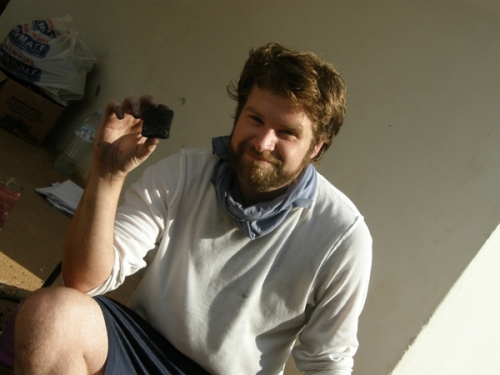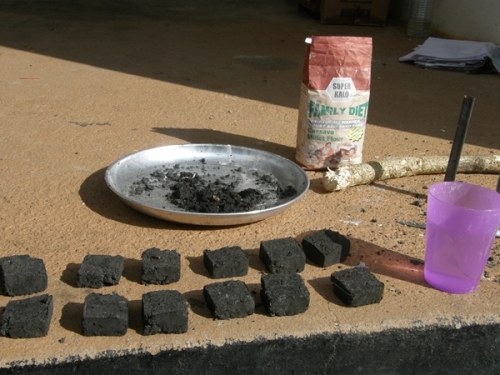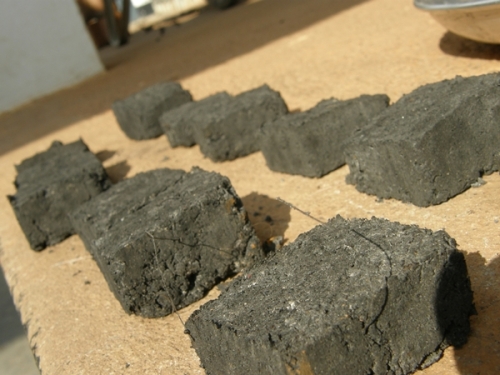Fuel from the fields
Each trimester Educate!’s program focuses on an innovative teaching technique: this trimester it is technology. Brendan is one of our Program Coordinators and our resident development technology expert. He has been very engaged and pro-active about doing research and testing. This is his account of one of his most recent experiments. He offers an interesting introduction to biomass fuel, a technology that our mentors and students can use to help reduce carbon emissions and counteract climate change.
 Brendan showing off the product of his research, corncob charcoal.
Brendan showing off the product of his research, corncob charcoal.
One of my responsibilities at Educate! is to write an environmental manual our students can use to inform the social initiatives they create. I have decided this manual will be half explanation of environmental issues within Uganda and half a practical manual on how to solve some of these problems. As such, I have set out to find solutions that the students can learn, apply, teach and practice: Educate! really encourages student experimentation and innovation.
One of the largest issues facing Uganda, and many countries in the world, is deforestation. Deforestation is a cause of soil erosion, and it can lower crop yields and increase wind in agricultural zones, as well as increase flooding. In Uganda, wood is used as a primary fuel source and to create charcoal. Both are commonly used throughout the country to cook and purify water. This usage is a cause of deforestation, and it puts a financial burden on many families due to its cost.
One of the first applications I looked into was charcoal creation out of non-wood biomass: using corncobs, banana peels, coffee grounds, husks and a variety of other agricultural waste as fuel. The burning of biomass is a serious cause of respiratory disease and can be a cause of childhood pneumonia. Wood burning is also a leading cause of indoor pollution. The issue is how to alter biomass so that is becomes a safe fuel alternative.
Charcoal is one solution. The charcoal creation process eliminates many of the harmful toxins in biomass, producing a safe fuel product. I began experimenting with corncobs, as there is a readily available supply in Kampala and in many parts of the country. A PDF called ‘Fuel from the Fields’, created by an organization called Practical Action with some assistance from the MIT D-Lab, served as my theoretical basis.
All you need to make corncob charcoal is a press, a container to burn the charcoal in and a starchy substance to bind the charcoal. A welder made my press to order, using a blueprint found on the MIT-DLab website.

Some of the production materials and finished charcoal.
I stuck some starter material into the bottom of the drum—mainly dried grass and banana leaves found in the back of our yard. I then put a large stick in the middle of the drum to create the chimney and filled it with corncobs. I lit both the top and bottom; the cobs ignited relatively quickly. Initially, the drum will emit white smoke, which will then become yellowish and much thicker. The yellow tint means flammable gases are being emitted and you can actually light the smoke to create a flame that burns more evenly.
The next part is a bit tricky: if you seal the drum too early, then many of the cobs will not carbonize and if you seal the drum too late, there will be too much ash. Now that you have sealed your barrel, let it sit for two to three hours, or until it is cooled. Then open the top, sprinkle some water to keep down dust, and there you have it: a barrel of carbonized corncobs.
To make the charcoal, you then crush the cobs into dust, mix it with the starch base and compact it using the press. The briquettes then take about two days to dry in the sun. They burn very well, and generate a considerable amount of heat. I was able to boil a cup of water, and I also cooked a nice hamburger and sausage, using only a handful of the briquettes. More excitingly, this process allowed me to easily create fuel using agricultural waste.
 Some of the charcoal briquettes.
Some of the charcoal briquettes.
Whether it is teaching a community how to lower fuel costs while improving their health, or simply becoming aware of an easy alternative energy processes, I am optimistic that our students can practically apply this process to their community projects. Development technology does not always seem to be geared toward the populations that need it most, nor do many people in Uganda have the luxury of internet or expansive libraries to research and explore. One of Educate!’s strengths as an organization is that we work with so many youth in different parts of the country, and we can expose them to these processes and technologies. It is exciting to experiment by myself and cook food on homemade charcoal, but I am far more excited for our students to get back from holiday, take these ideas and run with them.
